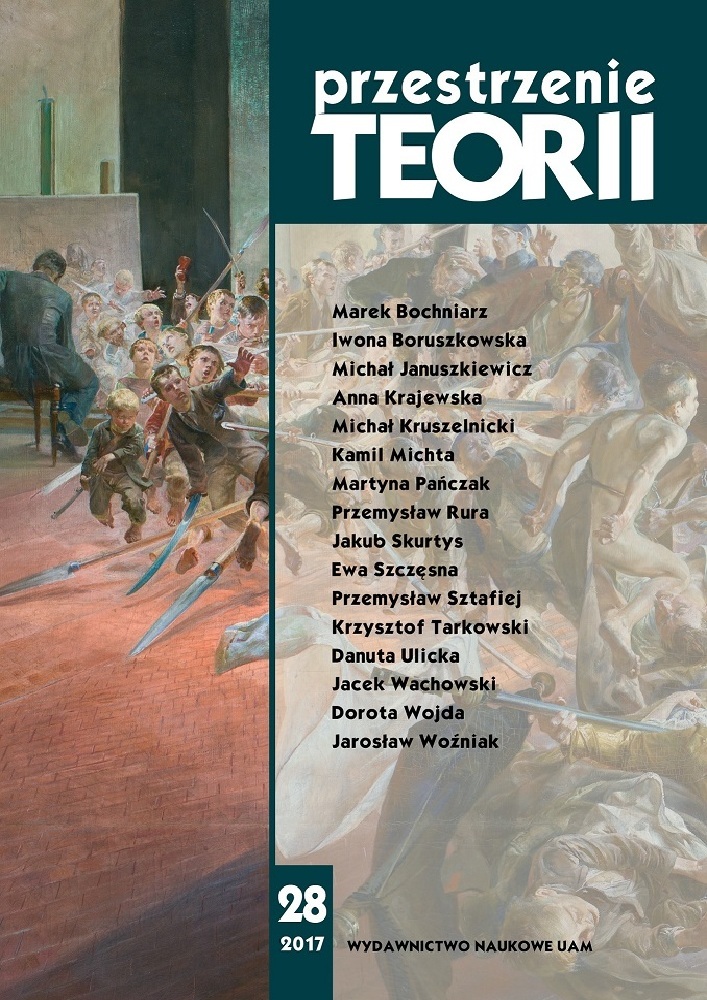Abstrakt
The Norwegian novelist Knut Hamsun’s outstanding early novel Pan. From Lieutenant Thomas Glahn’s Papers (1894) is often acknowledged as a manifestation of the specificity and profundity of Hamsun’s perception of nature. Contrary to the prevailing opinion, I argue that the novel’s main protagonist cannot be simply seen as the happily fulfilled “man of nature” for whom he wishes to pass. In a critical dialogue with the post-Romantic interpretations of Pan and drawing on some classic philosophical traditions (i.e. Rousseau, Schiller) as well as the modern Norwegian scholarship, I explore the psychological dimension of Hamsun’s masterpiece and present Glahn as an individual who attempts to erase or at least mystify within a personalized narrative the conflict between the objective world and his subjective perception of reality. This predicament seems essential to understanding Glahn’s character and ipso facto Hamsun’s less obvious position in the philosophical debate on the essence of modernity conceived as “Disenchantment”. By carefully following Glahn’s narratives centered on his experience of nature, I reveal their artificial and simulating character. Such a reading allows me to argue that Hamsun’s Pan concurs in a subtler language of literature with the philosophical acknowledgement, dating back to Rousseau, of the impossibility of the individual’s return to the pre-modern time, as if to the realm of original, transcendental sense and immediacy of our experience of the world. The horizons of the modern – perhaps suffice to say: mature? – historicized and highly reflexive consciousness cannot be transgressed; the Romantic sensitivity, in its naïve search for the authentic experience of nature as a source of the self and the sense, can only regain it in discourse, which amounts to positing nature as a beautiful appearance and thus compensating for one’s dramatic feeling of alienation from nature and being conceived of as a metaphysical “wholeness”.
Bibliografia
Andersen B., Det hjemlige og det fremmede i Hamsuns “Pan”, [w:] Hamsun 2000, ed. E. Arntzen, Tromsø 2000.
Andreas-Salomé L., Skandinavische Dichter, „Cosmopolis. International Revue” 1896, nr 4.
Baczko B., Rousseau: samotność i wspólnota, Gdańsk 2009.
Bataille G., Teoria religii, przeł. K. Matuszewski, Warszawa 1996.
Bielik-Robson A., My, romantycy. Źródła romantycznego modernizmu Charlesa Taylora, (Wstęp) [do:] Ch. Taylor, Źródła podmiotowości. Narodziny tożsamości nowoczesnej, Warszawa 2012.
Bishop P., The timeliness and timelessness of the ‘archaic’: analytical psychology, ‘primordial’ thought, synchronicity, „Journal of Analytical Psychology” 2008, vol. 53, issue 4.
Brynildsen A., Svermeren og hans Demon. Fire essays om Hamsun: 1952–1972, Oslo 1973.
Cooper L.D., Rousseau and Nature. The Problem of the Good Life, University Park 1999.
Fleischman S., Tense and Narrativity: From Medieval Performance to Modern Fiction, Austin 1990.
M. Giering, J. Thobo-Carlsen, M. Westergaard-Nielsen, Det reaktionære oprør. Om fascismen i Hamsuns forfatterskapp, Copenhague 1975.
Hamsun K., Pan. Z papierów porucznika Tomasza Glahna, przeł. Cz. Kędzierski, Poznań 1959.
Hamsun T., Knut Hamsun – min far, Oslo 1987.
Humpàl M., The Roots of Modernist Narrative: Knut Hamsun’s Novels: Hunger, Mysteries, and Pan, Oslo 1998.
Holbye K.J. R., Dødelig Idyll. Vold, myte og sivilisasjon i Knut Hamsun: „Pan. Af Løjtnant Thomas Glahns Papirer”, Våren 2007.
Kruszelnicki M., A Heideggerian reading of Knut Hamsun’s „Growth of the Soil”, „ Hybris.
Internetowy Magazyn Filozoficzny” 2012, nr 17.
Landquist J., Knut Hamsun. En studie over en nordisk romantisk diktare, Stockholm 1917.
Leder A., Psychoanaliza a politeizm, [w:] Freud i nowoczesność, red. Z. Rosińska, J. Michalik, P. Bursztyka, Kraków 2009.
Lewandowski A., Nietzsche i romantyczne niebezpieczeństwa nowoczesności, [w:] Nietzsche i romantyzm, red. M. Kruszelnicki, W. Kruszelnicki, Wrocław 2013.
Löwenthal L., Knut Hamsun. Zur Vorgeschichte der autoritären Ideologie, „Zeitschrift für Sozialforshung” 1937, nr VI.
Lyngstad S., Knut Hamsun, Novelist. A Critical Assessment, New York 2005.
Matuszewski K., Georges Bataille – Inwokacje zatraty, Łódź 2006.
Nesby L., En analyse av Knut Hamsuns romaner „Pan”, „Markens Grøde” og „Landstrykere” med utgangspunkt i kronotopbegrepet, Ph.d.-avhandling Det humanistiske fakultet, Universitetet i Tromsø, November 2008.
Nettum R.N., pt. Konflikt og visjon. Hovedtemaer i Knut Hamsuns forfatterskap 1890–1912, Oslo 1970.
Nettum R.N., Pan, [w:] Søkelys på Knut Hamsuns 90-års Diktning, ed. Ø. Rottem, Oslo 1979.
Rottem Ø., Hamsun og fantasiens triumf, Oslo 2002.
Rousseau J.J., Geneza społeczeństwa i jego sprzeczności, przeł. B. Strumiński, [w:] Filozofia francuskiego Oświecenia, wyboru dokonał oraz wstępem i przypisami opatrzył Bronisław Baczko, Warszawa 1961.
Schiller F., O poezji naiwnej i sentymentalnej, [w:] tegoż, Listy o estetycznym wychowaniu człowieka i inne rozprawy, przeł. J. Prokopiuk, Warszawa 1972.
Skavlan E., Knut Hamsun, Oslo 1929.
Wærp H.H., Northern scenery or symbolic landscape? „Pan”, „Ottar” 2009, nr 275.
Licencja
Autorzy
Autorzy tekstów przyjętych do publikacji w czasopiśmie „Przestrzeniach Teorii” są zobowiązani do wypełnienia, podpisania i odesłania na adres redakcji umowy o udzielenie nieodpłatnej licencji do utworów, z zobowiązaniem do udzielania sublicencji CC.
Zgodnie z umową, autorzy tekstów opublikowanych w czasopiśmie „Przestrzeniach Teorii” udzielają Uniwersytetowi im. Adama Mickiewicza w Poznaniu niewyłącznej i nieodpłatnej licencji oraz zezwalą na użycie sublicencji Creative Commons Attribution-NonCommercial-NoDerivatives 4.0 International (CC BY-NC-ND 4.0).
Autorzy zachowują prawa do dalszego, swobodnego rozporządzania utworem.
Autorzy, którzy wykorzystują w swoim tekście cudze utwory (np. ilustracje, fotografie) proszeni są o dostarczenie do redakcji czasopisma zgodę na publikację od uprawnionych podmiotów.
Użytkownicy
Zainteresowani użytkownicy internetu uprawnieni są do korzystania z utworów opublikowanych po 2015 roku „Przestrzeniach Teorii” tylko w calach niekomercyjnych, pod następującymi warunkami:
- uznanie autorstwa - obowiązek podania wraz z rozpowszechnionym utworem, informacji, o autorstwie, tytule, źródle (odnośniki do oryginalnego utworu, DOI) oraz samej licencji;
- bez tworzenia utworów zależnych - utwór musi być zachowany w oryginalnej postaci, nie można bez zgody twórcy rozpowszechniać np. tłumaczeń, opracowań.
Do wszystkich tekstów opublikowanych przed 2015 r. prawa autorskie są zastrzeżone.
Inne
Uniwersytet im. Adama Mickiewicza w Poznaniu zachowuje prawo do czasopisma jako całości (układ, forma graficzna, tytuł, projekt okładki, logo itp.).
